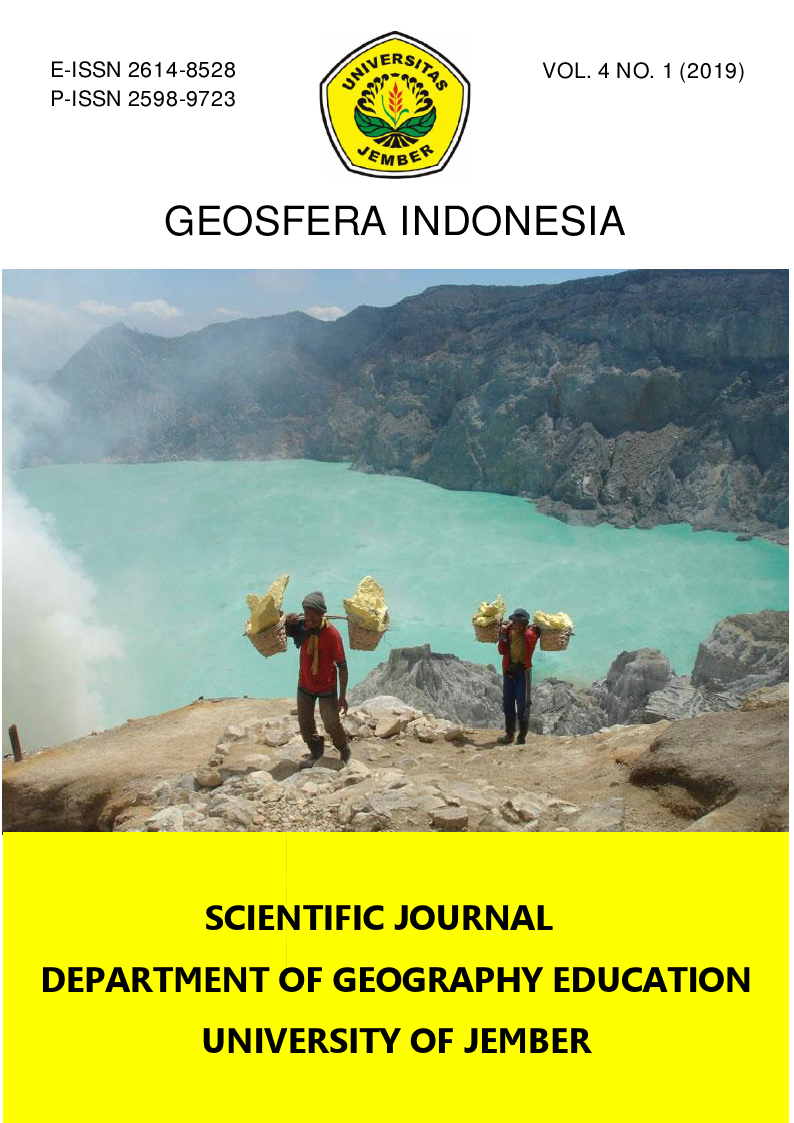HYDRO-GEOMORPHIC FACTORS AND THE POTENTIAL OF HYDROKINETIC POWER PRODUCTION UPSTREAM OF IKERE GORGE DAM, NIGERIA
DOI:
https://doi.org/10.19184/geosi.v4i1.9511Keywords:
Hydrokinetics, Hydraulic head, Gorge, Kinetic energy, Flow rate, VelocityAbstract
The operation of hydrokinetic turbine depends on river flow and pressure head (∆H) which are of high potential in many parts of Nigeria. This study attempts the analysis of the potential of the area upstream of Ikere Gorge dam for hydrokinetic potential. Soil and Water Assessment Tool (SWAT) was used to determine the hydrological parameters of the sub-basins. Pearson Moment Correlation and linear regression methods were used to find the relationships between morphometric properties and the discharge parameters. Hydrological modeling and statistical computations were done to estimate the theoretical potential of the catchment. The result shows that River Oshe has 9.542 MW, which is the highest potential while River Konsun with 1.161 MW has the lowest potential Pearson Moment Correlation shows that there is strong positive relation of 0.7 between slope and pressure head (∆H) at 0.05 significant levels. The result of the multiple regression show that hydro-geomorphic factors explained 59.1% of the variance in the explanation of hydrokinetic power potential upstream of Ikere gorge dam.
References
Alaska Center for Energy and Power (ACEP) (2011). Hydrokinetic energy (In-River, Tidal and
Ocean Current), Retrieved from http://energy-alaska.wikidot.com/ on April 20th, 2014
Aschenbrenner, F. (2008). Innovation on traditional waterwheels for renewable energy //
Power electronics and motion Control conference, Portoroz, Slovenia, pp.1625
Bahleda, M., and Hosko, M. A. (2007). Assessment of water power potential and development
Needs: Electric power research institute, California
Bhattacharya, A.K., and Bolaji, G.A. (2012). Fluid Flow Interactions in Ogun River,
International Journal of Research and Reviews in Applied Sciences, 2 (2): 22-23.
Electric Power Research Institute, EPRI (2012). Fish passage through turbine: Application of
convectional hydropower data to hydrokinetic technology Palo Alto, USA
Energy Information Administration (2014). Retrieved on Dec. 20th, 2014 from
www.eia.gov/electricity
Epler, J. (2010). Tidal Resources characteristics from acoustics Doppler current profiler, An
Unpublished M.Sc.Thesis, Department of Mechanical Engineering, University of Washington, USA
Evan, M. (2012). Hydrokinetic Power: An Analysis of Its Performance and Potential in the Roza
and Kittas Canals. An Unpublished M. Sc. Thesis, the Evergreen State College, USA
Ifabiyi, I.P. and Wahab, S. (2017). Theoretical potential of hydrokinetic energy in the Upper
Ogun and Upper Kaduna River basins, Nigeria. Journal of Sustainable Development in Africa, 19 (1): 242-256. Clarion University of Pennsylvania, Clarion, USA. ISSN: 1520-5509. Jsd-africa@clarion.edu
Kosnik, L. (2008). The Potential of Water Power in the Fight against Global Warming in the
USA, Energy policy, doi: 10.1016/ J. enpol. (05), 009.
Kusakana, K., and Vermaak, H. J. (2013). Hydrokinetic Power Generation for Rural Electricity
Supply: Case of South Africa. Renewable Energy, 1 (55): 467-73.
Ladokun, L.L., Ajao, K.R., and Sule, B.F. (2013). Hydrokinetic Energy Conversion System: Pros
-pects and Challenges in Nigerian Hydrological setting, Nigerian Journal of Technology, 3 (32): 538-549.
Miller, V.B, Ramde, E.W., Grandoville, R.T., and Schaefer, L.A. (2010). Hydrokinetic Power
for Energy Access in Rural Ghana, Renewable Energy International Journal, 1(36): 671-675.
Mohibullah, M., Radzi, A. M., and Hakim, M.I.A. (2004). Basics Design Aspects of Micro
Hydropower Plant and Its Potential Development in Malaysia // Power and Energy
Conference, Kualar Lumpur, pp. 220-223.
Neitsch, S.L, Arnold, J.G., Kiniry, J.R and Williams, J.R. (2009). Soil and Water Assessment
Tool Theoretical Documentation Version 2009 Grassland, Soil and Water Research Laboratory-Agriculture Research Service, Blackland Research Center- Texas Agrilife Research., USA.
Ofuani, A.I. (2013). Combating climate change through renewable energy legislation in
Nigeria: Prospects and Challenges. Paper Presented at university of Ilorin/ UCC (Ghana) International Conference held at university of Ilorin. May 1st-4th 2011.
Stephen, V.A, Paul, T.A., and Daniel, J.G. (2012). Survival and Behaviour of Fish interacting
With Hydrokinetic Turbines, 9th ISE, Vienna, USA
Vermaak, H.J., Kusakana, K., and Koko, S.P. (2013). Status of Micro-hydrokinetic River
Technology in Rural Applications: A Review of literature: Renewable and sustainable
energy reviews, 29(14): 625-633.
Wahab, S., Ifabiyi, I.P. and Adeogun, A.G. (20017). SWAT analysis of Ikere Gorge Basin for
Hydrokinetic power estimation in selected rural settlement of Oke Ogun, Nigeria. Ruhuna Journal of Science. 8(2):24-43 Ruhuna, Faculty of Science, University of Ruhuna, Sri Lanka. eISSN: 2536-8400. DOI: http//:doi.org/10.4038/rjs.v8il.
Copyright (c) 2019 Geosfera Indonesia Journal and Department of Geography Education, University of Jember

This work is licensed under a Creative Commons Attribution-Share A like 4.0 International License



